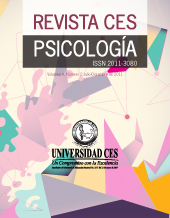Frontal Neuropsychological Syndrome as a Consequence of Normal Tension Hydrocephalus: a case study
DOI:
https://doi.org/10.21615/cesp.11.1.2Keywords:
Qualitative Neuropsychology, Syndromic Analysis, Normal Pressure HydrocephalusAbstract
The clinical manifestation of Normal Pressure Hydrocephalus (NPH) implies loss of bladder sphincter control, gait disorder and cognitive impairment. The aim of this study is to describe the NPH patient’s functional neuropsychological state through a syndromic analysis, applying qualitative neuropsychological tests and assessment of intellectual activity. It is evidenced difficulties and errors, which characterize severe syndrome with self-regulation and control of the activity. In the case of NPH, such syndrome is a consequence of organic frontal damage. Systematic errors derived from a lack of planning, selectivity and self-criticism were observed in complex perceptual, verbal and intellectual tasks. In this case, the qualitative neuropsychological analysis supports the affirmation of a cortical atrophy with frontal predominance in NPH.
Downloads
References
Bech-Azeddine, R., Høgh, P., Juhler, M., Gjerris, F., & Waldemar, G. (2007). Idiopathic normal-pressure hydrocephalus: clinical comorbidity correlated with cerebral biopsy findings and outcome of cerebrospinal fluid shunting. Journal of Neurology, Neurosurgery & Psychiatry, 78(2), 157-161.
Bradley, W., & Bahl, G. (2006). Idiopathic normal pressure hydrocephalus may be a "two hit" disease: benign external hydrocephalus in infancy followed by Deep white matter ischemia in late adulthood. Journal of Magnetic Resonance Imaging, 24(4), 747-55.
Brean, A., & Eide, P. (2008). Prevalence of probable idiopathic normal pressure hydrocephalus in a Norwegian population. Acta Neurológica Scandinávica, 118, 48-53.
Bret, P., Chazal, J., Janny, P., Renaud, B., Tommasi, M., … Jouvet, A. (1990). Chronic hydrocephalus in adults. Neurochirurgie, 36(1), 1-159.
Pinto, F. C. G., Saad, F., Oliveira, M. F. de, Pereira, R. M., Miranda, F. L. de, Tornai, J. B., … Texeira, M.J. (2013). Role of Endoscopic Third Ventriculostomy and Ventriculoperitoneal Shunt in Idiopathic Normal Pressure Hydrocephalus: Preliminary Results of a Randomized Clinical Trial. Neurosurgery, 72(5), 845-854. doi:10.1227/NEU.0b013e318285b37c
Chang, S., Agarwal, S., Williams, M. A., Rigamonti, D., & Hillis, A. E. (2006). Demographic factors influence cognitive recovery after shunt for normal-pressure hydrocephalus. The neurologist, 12(1), 39-42.
Declaración de Helsinki. (1975). World Medical Association Assembly: Tokyo, Japón.
De la Calzada, M., Sahuquillo, J., Matarín, M., & Solana, E. (2010). Potenciales evocados cognitivos (P300) en pacientes con hidrocefalia de presión normal. Neurología, 25(1), 32-39.
Duinkerke, A., Williams, M. A., Rigamonti, D., & Hillis, A. E. (2004). Cognitive recovery in idiopathic normal pressure hydrocephalus after shunt. Cognitive and behavioral neurology, 17(3), 179-184.
Fersten, E., Głowacki, M., Walasek, N., & Jurkiewicz, J. (2004). Diagnostic difficulties due to atypical symptoms in normal pressure hydrocephalus. A case report. Neurologia i neurochirurgia polska, 39(3), 247-251.
Gleichgerrcht, E., Cervio, A., Salvat, J., Loffredo, A. R., Vita, L., Roca, M., … Manes, F. (2009). Executive function improvement in normal pressure hydrocephalus following shunt surgery. Behavioral Neurology, 21(3), 181–185.
Hellström, P., Edsbagge, M., Archer, T., Tisell, M., Tullberg, M., & Wikkelsø, C. (2007). The neuropsychology of patients with clinically diagnosed idiopathic normal pressure hydrocephalus. Neurosurgery, 61(6), 1219-1228.
Illán-Gala, I., Pérez-Lucas, J., Martín-Montes, A., Mánez-Miró, J., Arpa, J., & Ruiz-Ares G. (2017). Evolución a largo plazo de la hidrocefalia crónica del adulto idiopática tratada con válvula de derivación ventrículo-peritoneal. Neurología, 32, 205-212.
Iseki, C., Takahashi, Y., Wada, M., Kawanami, T., Adachi, M., & Kato, T. (2014). Incidence of idiopathic normal pressure hydrocephalus (iNPH): a 10-year follow-up study of a rural community in Japan. Journal of the Neurological Sciences 339, 108-112.
Jha, S., & Patel R. (2004). Some observations on the spectrum of dementia. Neurology India, 52(2), 213-4.
Klinge, P., Hellstrom, P., Tans, J., & Wikkelso, C. (2012). One-year outcome in the European multicentre study on iNPH. Acta Neurológica Scandinávica, 126,145–53.
Koivisto, A. M., Alafuzoff, I., Savolainen, S., Sutela, A., Rummukainen, J., Kurki, M., & Leinonen, V. (2013). Poor cognitive outcome in shunt-responsive idiopathic normal pressure hydrocephalus. Neurosurgery, 72(1), 1-8.
Luria, A.R. (1979). El cerebro humano y los procesos psíquicos. Barcelona: Editorial Fontanella.
Marmarou, A., Bergsneider, M., Klinge, P., Relkin, N., & Black, P. M. (2005). The value of supplemental prognostic tests for the preoperative assessment of idiopathic normal-pressure hydrocephalus. Neurosurgery, 57(3), S2-17.
Martín-Láez, R., & Vázquez-Barquero, A. (2016). Pronóstico a largo plazo de la hidrocefalia crónica del adulto idiopática: I. Protocolo diagnóstico-terapéutico del Hospital Universitario Marqués de Valdecilla. Neurocirugia, (in press).
Martín-Láez, R., Caballero-Arzapalo, H., López-Menéndez, L., Arango-Lasprilla, J., & Vazquez-Barquero, A. (2015). Epidemiology of idiopathic normal pressure hydrocephalus: a systematic review of the literature. World neurosurgery, 84(6), 2002-2009.
McGirt, M., Woodworth, G., Coon, A., Thomas, G., Williams, M., & Rigamonti, D. (2005). Diagnosis, treatment, and analysis of long-term outcomes in idiopathic normal-pressure hydrocephalus. Neurosurgery, 57, 699-705.
Pfisterer, W. K., Aboul-Enein, F., Gebhart, E., Graf, M., Aichholzer., M. & Mühlbauer, M. (2007). Continuous intraventricular pressure monitoring for diagnosis of normal-pressure hydrocephalus. Acta neurochirurgica, 149(10), 983-990.
Quintanar, L., & Solovieva, Y. (2012). Evaluación neuropsicológica de la actividad escolar. México: Benemérita Universidad Autónoma de Puebla.
Rodríguez, M. Herrera, D., Sánchez, A., & Herrera, M. (2017). Hidrocefalia normotensa. Presentación de un caso Normal Pressure Hydrocephalus. Case Presentation. Revista de Ciencias Médicas de Cienfuegos, 15(1), 113 – 119.
Rowland, J. T., Basic, D., Storey, J. E., & Conforti, D. A. (2006). The Rowland Universal Dementia Assessment Scale (RUDAS) and the Folstein MMSE in a multicultural cohort of elderly persons. International Psychogeriatrics, 18(01), 111-120.
Sahuquillo, J., Rubio, E., Codina, A., Molins, A., Guitart, JM., Poca, MA., & Chasampi, A. (1991). Reappraisal of the intracranial pressure and cerebrospinal fluid dynamics in patients with the so-called "normal pressure hydrocephalus" syndrome. Acta Neurochirurgica, 112(1-2), 50-61.
Solana, E., Sahuquillo, J., Junqué, C., Quintana, M., & Poca, M. (2012). Cognitive Disturbances and Neuropsychological Changes after Surgical Treatment in a Cohort of 185 Patients with Idiopathic Normal Pressure Hydrocephalus. Archives of clinical neuropsychology, 27, 304–317.
Solovieva, Y., & Quintanar, L. (2013). Evaluación neuropsicológica breve para adultos. México: Benemérita Universidad Autónoma de Puebla.
Solovieva, Y., & Quintanar, L. (2012). Protocolo de evaluación de las funciones visuales y espaciales. México: Benemérita Universidad Autónoma de Puebla.
Srikanth, S., & A. V. Nagaraja. (2005). A prospective study of reversible dementias: frequency, causes, clinical profile and results of treatment. Neurol India, 53(3), 291-6.
Stolze, H., Kuhtz-Buschbeck, J. P., Drücke, H., Jöhnk, K., Illert, M., & Deuschl, G. (2001). Comparative analysis of the gait disorder of normal pressure hydrocephalus and Parkinson's disease. Journal of Neurology, Neurosurgery & Psychiatry, 70(3), 289-297.
Tarnaris, A., Toma, A., Kitchen, N., & Watkins, L. (2009). Ongoing search for diagnostic biomarkers in idiopathic normal pressure hydrocephalus. Biomarkers, 3(6), 787- 805.
Tsvetkova, L.S. (1999). Neuropsicología del intelecto. México: Universidad Autónoma de Cuernavaca.
Zipfel, G. (2014). Normal pressure hydrocephalus. Neurosurgery, 121, 769–770.
Downloads
Published
How to Cite
Issue
Section
License
Copyright (c) 2017 Omar Elías Torrado Duarte, Yulia Solovieva, Elsa Paola Quezada Richart

This work is licensed under a Creative Commons Attribution-NonCommercial-ShareAlike 4.0 International License.
Each manuscript is accompanied by a statement specifyingThat the materials are unpublished, that have not been previously published in printed formatElectronic and that they will not be presented to any other means before knowing the decision of the magazine. ThroughoutIn case, any previous publication, sea in printed or electronic form, must be made known to the editorial staffWriting The authors attach a signed statement stating that, and the manuscript is acceptedFor publication, the rights of reproduction are the exclusive property of the Journal CES Psychology.| Article metrics | |
|---|---|
| Abstract views | |
| Galley vies | |
| PDF Views | |
| HTML views | |
| Other views | |




